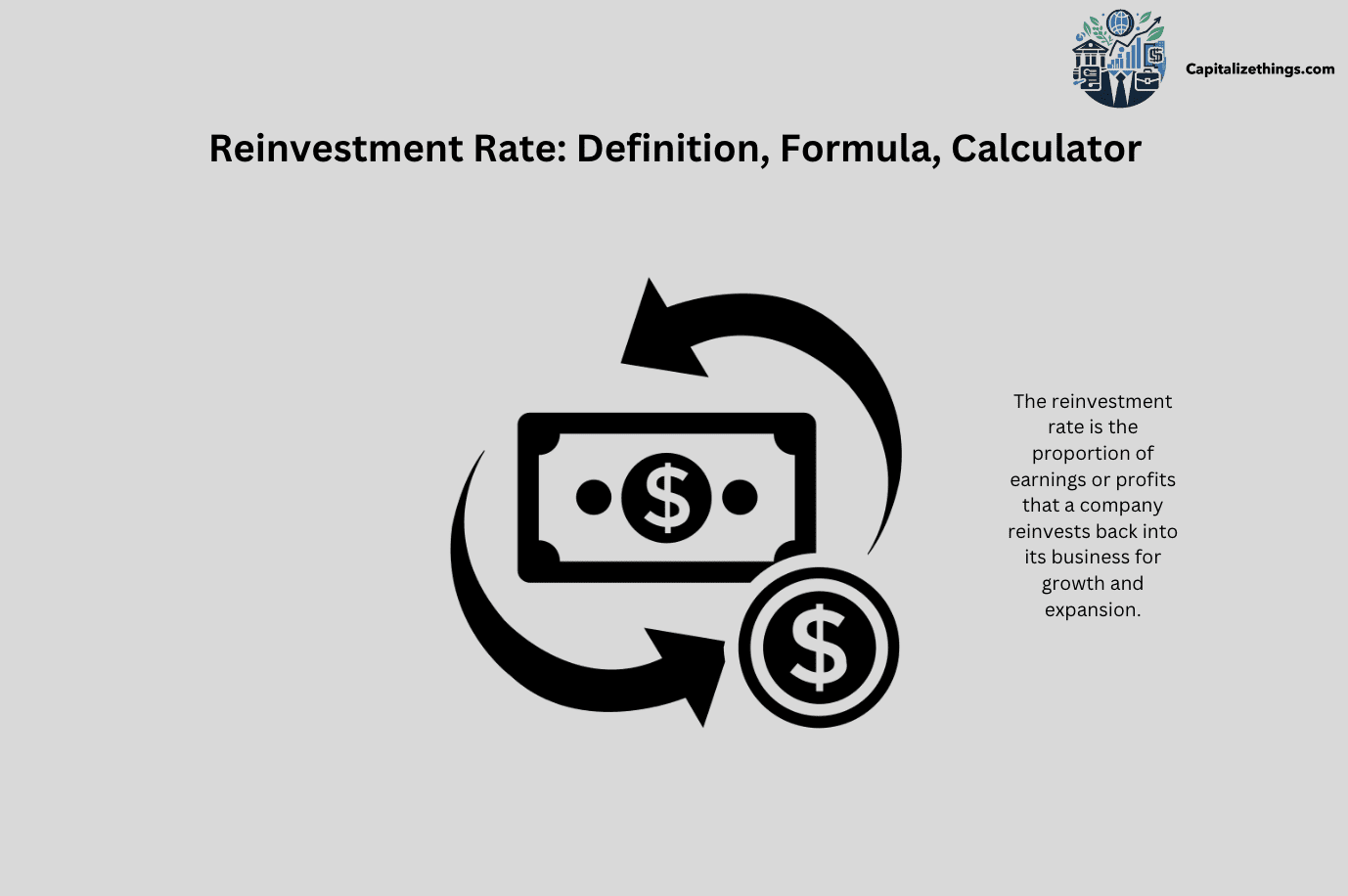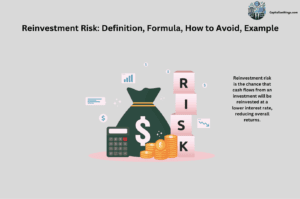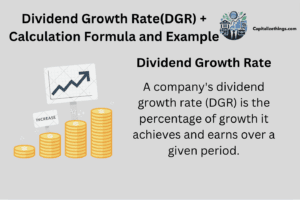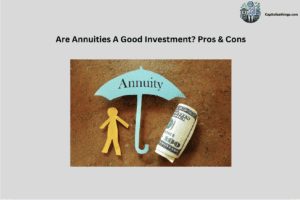The reinvestment rate is the percentage of an organization’s earnings or coins that is reinvested again into the commercial enterprise as opposed to paid out to shareholders as dividends. Companies reinvest to develop, purchase assets, or increase operations. This price displays how much the organization is focused on increasing. A better reinvestment price often indicates aggressive boom strategies.
The formula to calculate the reinvestment rate is:
Reinvestment Rate= (Net Income-Dividends)/(Net Income)×100
This formula shows the portion of the company’s earnings that is reinvested. A reinvestment rate calculator can help you quickly compute the reinvestment rate by inputting the company’s net income and dividends. Our financial websites provide free calculator that automates the process. Simply input the relevant data, and the calculator will show how much of the company’s earnings are being reinvested for growth. Scroll down for our advanced reinvestment rate calculator.
Elevate your portfolio performance with our cutting-edge reinvestment rate optimization tools. CapitalizeThings.com provides innovative solutions to help you make informed decisions. Contact us at +1 (323)-456-9123 for a free 15-minute call and discover how we can enhance your investment strategy.
What Is The Reinvestment Rate?
The reinvestment rate indicates how much of an organization’s profits are put returned into the commercial enterprise. Companies use this cash to buy new assets, develop, or improve operations. This facilitates the employer increase and do higher over the years. The reinvestment price is usually seen to inform how much an organization is focused on growth.
When an employer has a better reinvestment charge, they’re focused on an increase. They are the usage of their cash to make the business bigger. A lower reinvestment charge method a corporation gives greater of its profits again to shareholders via dividends. Different organizations select a whole lot to reinvest relying on their desires.
Some corporations reinvest to improve devices or rent more human beings. Other corporations can also reinvest to discover new markets. The reinvestment price is beneficial for knowledge of how a corporation uses its earnings to develop.
What Is The Reinvestment Rate In IRR?
The reinvestment rate in Internal Rate of Return (IRR) suggests how an awful lot of money a business enterprise places again into tasks at the identical fee. IRR measures the predicted return from a venture. The reinvestment rate assumes the corporation will earn this go back if it reinvests its earnings.
Using IRR facilitates an enterprise recognizing if its projects are earning sufficient. If the reinvestment charge fits the IRR, the organization is making its cash paintings. IRR additionally suggests whether a task will deliver income in the destiny by using reinvesting profits on the identical rate.
A better reinvestment charge in the IRR approach means more money is used for new projects. This maintains the enterprise developing at a consistent tempo. If the reinvestment fee is decreased than the IRR, the corporation might not use its cash in addition to it could.
What Is Reinvestment Rate Risk?
Reinvestment rate risk is the hazard that destiny interest rates can decrease. This can reduce the returns a commercial enterprise receives while it reinvests its income. Companies face this threat when they cannot reinvest at the identical price as earlier than. Lower interest fees imply the organization will earn less money on new investments.
When interest charges drop, the enterprise can’t make as many benefits from reinvesting. This makes it more difficult to grow and extend. Reinvestment fee hazard can hurt corporations that depend on regular increase. Investors additionally worry about this threat as it influences how much they earn.
Some agencies try to avoid this threat by way of investing in longer-term projects. This allows them to lock in better returns before interest quotes drop. They also can use different techniques to guard their destiny income from lower interest costs.
What Is Reinvestment Rate In Stable Growth?
The reinvestment rate in stable growth indicates how many businesses reinvest in the course of gradual, steady increase. At this level, an organization isn’t always growing fast, but it’s miles nonetheless developing. The company uses its earnings to improve its cutting-edge operations in preference to make bigger into new regions.
Stable increase groups often reinvest a smaller part of their earnings. They might not need as much new investment due to the fact they are already installed. These corporations focus on enhancing what they have got, like updating devices or training employees.
During strong growth, an organization can nonetheless do properly without massive investments. They also return more money to shareholders through dividends. A strong reinvestment rate we could have the agency live strong and avoid risks while maintaining gradual and steady growth.
How Does Reinvestment Rate Work?
The reinvestment rate works using an organization’s earnings to fund new increases or enhance its commercial enterprise. This could consist of shopping for new gear, expanding factories, or hiring extra human beings. The greater a corporation reinvests, the greater it can develop. Reinvestment prices are special for each corporation relying on their dreams.
An organization with a high reinvestment price spends most of its income on growing. They additionally put their money into new merchandise or markets. An agency with a low reinvestment charge focuses greater on giving money back to shareholders.
Each employer plans on how much to reinvest relying on its wishes. Some organizations grow fast, while others stay the same. The reinvestment charge facilitates buyers to see how an employer makes use of its profits for increase.
How Does Bond Reinvestment Work?
Bond reinvestment takes place while the money earned from bonds is used to buy more bonds. Bonds pay interest, and that interest can be reinvested. This helps the investor earn even more over time. Bond reinvestment shall we human beings grow their money with no need to do whatever else.
When a person reinvests bond interest, they are buying new bonds with their earnings. The greater bonds they own, the more they can earn. Reinvesting a bond interest is a simple manner to increase wealth through the years without extra risk.
Bond reinvestment is popular because traders maintain creating wealth. It facilitates them to grow their savings with little or no work. Over time, reinvested profits upload up, allowing humans to make more from their investments.
How Do You Calculate Reinvest Rate?
The reinvestment rate is calculated using this formula:
Reinvestment Rate = (Net Income-Dividends)/(Net Income)×100
This shows how much of the company’s earnings are reinvested back into the business. It helps investors see how focused the company is on growth. A higher percentage means more money is being reinvested.
To calculate the reinvestment rate, you need to know the company’s net income and dividends. Subtract the dividends from the net income. Divide that number by the total net income. Then, multiply by 100 to get the percentage. This gives you the reinvestment rate.
Let’s say a company has a net income of $1 million and gives $200,000 in dividends. Using the formula, subtract $200,000 from $1 million. That leaves $800,000. Now divide $800,000 by $1 million. The result is 0.8. Multiply 0.8 by 100 to get 80%. This means the company reinvests 80% of its earnings.
Reinvestment Rate Calculator
What Is Reinvestment Rate In DCF?
The reinvestment rate in DCF (Discounted Cash Flow) is the percentage of cash flow that a company reinvests back into its operations. This affects future growth. In a DCF model, the reinvestment rate helps estimate the future value of the company by predicting its future earnings. A higher reinvestment rate means the company is trying to grow faster.
In DCF, the reinvestment rate formula is:
Reinvestment Rate = Reinvestment/(Operating Income)
For example, if a company reinvests $500,000 from an operating income of $2,000,000, the reinvestment rate would be:
Reinvestment Rate=25%
A higher reinvestment rate in DCF assumes the company is focused on growth. This rate helps analysts understand how much cash flow will go back into the business. Companies with high growth targets usually have higher reinvestment rates. This rate affects how the company is valued, especially when forecasting future earnings.
What Is The Implicit Reinvestment Rate Assumption In The IRR Rule?
The implicit reinvestment rate assumption in the IRR (Internal Rate of Return) rule is that cash flows can be reinvested at the project's IRR. This assumption might be unrealistic because the actual reinvestment rate differs. The IRR rule assumes that all intermediate cash flows are reinvested at the same rate, which could overestimate returns.
In the IRR rule, the reinvestment formula is:
Reinvestment Rate=IRR
For example, if the IRR of a project is 10%, the assumption is that all cash flows will be reinvested at 10%. If the actual reinvestment rate is lower, the project's return could be less than expected. The IRR rule’s assumption about reinvestment rates affects investment decisions. It assumes that the company can always reinvest cash flows at the same rate. This is often not possible, which is why some prefer other methods like MIRR (Modified Internal Rate of Return).
What Is The Reinvestment Rate Assumption When Using MIRR?
The reinvestment rate assumption whilst the use of MIRR (Modified Internal Rate of Return) is that cash flows are reinvested at the company’s price of capital, not the mission’s IRR. This gives a greater sensible view of destiny income. MIRR adjusts the unrealistic assumption of the IRR rule via the usage of the value of capital because of the reinvestment price.
The MIRR reinvestment formula is:
Reinvestment Rate=Cost of Capital
For example, if a corporation’s price of capital is 8%, then cash flows are reinvested at 8%. This makes the reinvestment assumption greater practical in comparison to the IRR rule. MIRR affords an extra accurate mirrored image of an undertaking's profitability. By the usage of the corporation’s fee of capital, the reinvestment rate turns into greater sensible. This results in higher decision-making whilst evaluating initiatives or investments.
What Is The Reinvestment Rate Assumption And How Does It Affect The NPS Vs IRR Conflict?
The reinvestment rate assumption influences the NPV (Net Present Value) vs. IRR (Internal Rate of Return) warfare because each technique assumes special reinvestment prices. NPV assumes reinvestment on the price of capital, while IRR assumes reinvestment at the undertaker's IRR. This distinction can cause conflicting task ratings between NPV and IRR.
For instance, if the value of capital is 7%, NPV assumes reinvestment at 7%, at the same time as IRR would possibly anticipate a higher price. This can result in exclusive profitability estimates. The reinvestment fee assumption can cause the IRR to overestimate returns, at the same time as NPV gives an extra conservative estimate. Many analysts prefer NPV as it assumes an extra sensible reinvestment fee. This reduces the battle between NPV and IRR while comparing tasks.
What Is The Reinvestment Rate For E&P?
The reinvestment rate for E&P (Exploration and Production) agencies refers to the percentage of cash going with the flow reinvested into new exploration and improvement. E&P organizations regularly have excessive reinvestment rates because of the capital-extensive nature of the enterprise. These rates are crucial for maintaining production stages and locating new reserves.
The E&P reinvestment formula is:
Reinvestment Rate = (Capital Expenditure)/(Cash Flow)
For example, if an E&P company invests $1 billion from a cash flow of $3 billion, the reinvestment rate is:
Reinvestment Rate=33%
Higher reinvestment charges are not unusual in E&P to make sure destiny production. Companies have to reinvest continuously to replace depleting reserves. The reinvestment rate affects their potential to grow or preserve operations over the years.
What Is The Reinvestment Rate Of Oil And Gas?
The reinvestment rate of oil and fuel agencies is the proportion of cash glide that is put back into locating and growing new reserves. The oil and fuel enterprise is capital-extensive, so corporations tend to reinvest heavily. High reinvestment rates permit these organizations to preserve exploring new fields and retaining production ranges.
The oil and gas reinvestment formula is given below:
Reinvestment Rate= Capex/(Cash Flow from Operations)
For example, if an oil company has $500 million in capex from $2 billion in cash flow, the reinvestment rate would be:
Reinvestment Rate=25
Oil and gas companies need to reinvest regularly to preserve manufacturing and boom. An excessive reinvestment rate is important for these organizations to find new reserves and ensure lengthy-term sustainability.
What Is The Reinvestment Rate In Valuation?
The reinvestment rate in valuation refers to the proportion of cash flows that a corporation places back into the commercial enterprise to develop its value. This is important in discounted cash float (DCF) analysis. A better reinvestment fee shows that the agency is making an investment heavily to grow its future fee, even as a decrease fee shows a focus on balance.
In valuation, the reinvestment rate formula is:
Reinvestment Rate= Reinvestment/(Operating Income)
For example, if a company reinvests $1 million from an operating income of $4 million, the reinvestment rate would be 25%. In DCF, the reinvestment rate directly affects the company's future value. Higher rates imply aggressive growth and expansion, which can increase the company's value over time.
What Is The Reinvestment Rate Of Tata Motors?
The reinvestment price of Tata Motors refers to the proportion of its earnings that is positioned again into the business to drive growth. Tata Motors is a big vehicle organization that often reinvests its earnings to broaden new cars and enhance its manufacturing skills. This reinvestment allows the organization to stay competitive within the international market.
For example, if Tata Motors reinvests $500 million from $2 billion in internet earnings, the reinvestment fee would be 25%. Tata Motors’ reinvestment price displays its recognition of innovation and growth. By reinvesting in its operations, the organization can enhance its merchandise and toughen its market position.
What Is The Reinvestment Rate Of The Automobile Industry?
The reinvestment rate of the automobile industry refers to the percentage of earnings that car companies reinvest into developing new vehicles, technologies, and manufacturing facilities. The industry tends to have high reinvestment rates due to the need for continuous innovation and large capital investments. This allows companies to stay competitive and meet consumer demands.
Reinvestment Rate= Reinvestment/(Net Income)
For example, if an auto company reinvests $1 billion from $5 billion in net income, the reinvestment rate would be 20%. Automobile companies need to reinvest to keep up with changing technology and regulations. The reinvestment rate reflects how much of their profits go back into growing the business.
What Is The Reinvestment Rate Of A Company?
The reinvestment rate of a company is the percentage of its earnings that it puts back into its operations. This can include investments in new projects, equipment, and research. A higher reinvestment rate often indicates a company that is focused on growth, while a lower rate suggests a focus on stability or paying dividends to shareholders.
The reinvestment rate formula is:
Reinvestment Rate= Reinvestment/(Net Income)
For example, if a company reinvests $2 million from $10 million in net income, the reinvestment rate is 20%. Companies use their reinvestment rate to signal their growth strategies. Higher rates show that the company is aggressively expanding, while lower rates reflect a focus on shareholder returns.
Empower your decision-making with our exclusive reinvestment rate benchmarking reports. Gain invaluable industry insights from the specialists at capitalizethings.com. Contact +1 (323)-456-9123 for a free preview and elevate your company's financial performance today.
What Is The Reinvestment Rate Of Capex?
The reinvestment rate of capex refers to the percentage of a company's earnings that is spent on capital expenditures. This includes investments in new equipment, technology, and facilities. Companies with high capex reinvestment rates are usually focused on long-term growth and expansion, while those with lower rates focus on maintaining current operations.
The capex reinvestment formula is:
Reinvestment Rate= Capex/(Net Income)
For example, if a company spends $3 million on capex from $10 million in net income, the reinvestment rate would be 30%. Capex reinvestment is critical for companies that need to upgrade their equipment or expand their facilities. This helps ensure that they can continue to grow in the future.
What Is The Formula For Reinvestment Rate?
The formula for the reinvestment fee is used to calculate the percentage of an organization's income that is reinvested again into the enterprise. This formula facilitates traders to apprehend how much of the income is being used for increase. A better reinvestment rate means greater recognition of growth.
The formula is:
Reinvestment Rate = Reinvestment/(Net Income) x 100
If a business enterprise reinvests $two hundred,000 from $800,000 in net profits, the reinvestment rate might be 25%. This formulation is essential for evaluating an organization's growth strategy. High reinvestment rates display competitive growth, at the same time as low quotes would possibly suggest balance.
What Is The Reinvestment Rate Formula For Excel?
The reinvestment rate formula for Excel is a simple way to calculate how much of a company’s earnings are being reinvested. You can use basic functions in Excel to quickly compute the reinvestment rate. This helps track the company’s focus on growth and expansion over time.
The Excel formula is:
= Reinvestment/(Net Income) x 100
This formula will give you a reinvestment rate of 25%. Excel helps simplify financial calculations and allows for quick updates as new data becomes available.
What Is A Breakeven Reinvestment Rate?
A breakeven reinvestment rate is the point wherein the company's reinvestments are the same as its income. At this charge, the organization does not lose or benefit from reinvestments. It enables you to determine if the business is using its income correctly. Companies’ intention to reinvest just enough to develop without draining resources.
The breakeven reinvestment rate indicates how an awful lot a corporation should reinvest to maintain its modern size. If reinvestments are beneath this charge, the agency ought to cut back. If reinvestments are too excessive, the commercial enterprise would possibly overextend itself. The breakeven price facilitates stability among increase and balance.
To calculate the breakeven reinvestment charge, you evaluate earnings with reinvestment degrees. A balanced fee manner the company is solid. If reinvestment is higher, the business enterprise would possibly develop fast. If it decreases, the organization ought to face troubles keeping up with its competitors.
How Do You Calculate Reinvestment Interest?
To calculate reinvestment interest, you study the quantity of money put again into a business. This interest is the profit from reinvestments over time. It's important for organizations to measure how well their reinvestments are working. Reinvestment interest allows one to look if the company's growth is sustainable.
Reinvestment interest is based on how tons the organization earns from the money it reinvests. It shows if the enterprise's investments are paying off. If the reinvestment interest is excessive, the employer is growing nicely. If it's low, the enterprise won't use its funds wisely.
Businesses calculate reinvestment interest by looking at their reinvested earnings and evaluating them to earnings. A high interest rate approaches the reinvestments are running. A low charge suggests that the organization ought to rethink its strategy. This measure enables the agency to grow properly.
How To Calculate Reinvestment Rate For ROIC?
The reinvestment rate for ROIC measures how a whole lot of a business enterprise's returns are reinvested. ROIC stands for return on invested capital. This price suggests how a good deal the corporation is using its income to fund a similar increase. Calculating this rate enables us to peer if the organization is developing sustainably.
To calculate the reinvestment fee for ROIC, take the reinvested earnings and divide with the aid of the whole capital. This system shows what portion of profits is going back into the commercial enterprise. A higher rate way the business enterprise is focusing greater on growth. A lower price suggests the business not reinvesting tons.
The reinvestment charge for ROIC is useful in measuring a company’s performance. A higher rate can suggest better use of earnings. If the fee is too low, the company can also battle to grow. Investors use this to determine if a corporation is using its resources efficiently.
How To Calculate Capital Reinvestment Rate?
The capital reinvestment rate measures how lots of a corporation’s capital is reinvested into its business. This facilitates help to see if the corporation is placing enough cash back into its operations. An high capital reinvestment rate manners the enterprise is centered on developing and expanding.
To calculate the capital reinvestment price, take the quantity of capital reinvested and divide by way of the whole capital. This suggests the share of cash going lower back into the employer. It’s an important measure for businesses aiming to grow. A low rate suggests the corporation isn’t investing sufficiently in its destiny.
The capital reinvestment fee enables investors recognize the business enterprise’s growth capacity. An excessive reinvestment charge shows an organization is aggressively expanding. If the rate is low, the business focuses extra on maintaining its contemporary length as opposed to developing.
How To Calculate The Reinvestment Rate For Oil And Gas?
The reinvestment rate for oil and gas indicates how a great deal of the earnings in this industry are reinvested into new initiatives. This charge allows oil and gasoline businesses to preserve production stages and discover new reserves. Calculating this fee is essential for sustaining lengthy-time period operations.
To calculate the reinvestment rate for oil and gas, you evaluate the quantity spent on new projects with general earnings. This offers a percentage that shows how a lot of the employer's income is getting used to fund destiny manufacturing. A high reinvestment price shows a focus on boom and enlargement.
The oil and gasoline industry calls for great reinvestment to stay aggressive. An excessive reinvestment price enables businesses to discover new reserves and build infrastructure. If the rate is too low, the agency battles to keep production ranges. It is essential for long-time period sustainability in this industry.
How Do You Calculate Net Reinvestment Rate?
The net reinvestment rate shows how a great deal of an enterprise's income is reinvested after expenses. It helps agencies determine how a whole lot of their earnings are going returned into operations. This price is crucial for businesses aiming for a lengthy-time period boom and sustainability.
To calculate the net reinvestment rate, subtract fees from total profits after which divide by total earnings. This gives the share of profits being reinvested. A higher net reinvestment price method means the organization is putting more money back into its increase. A decrease fee suggests the business enterprise can also need to reinvest greater.
Businesses with an excessive net reinvestment rate are commonly focused on enlargement. They are using their earnings to build and grow. A lower price would possibly indicate that the agency is preserving its modern length or going through financial challenges. The internet reinvestment charge is a key measure of boom ability.
What Is The Reinvestment Rate Of NPV?
The reinvestment rate of NPV (Net Present Value) suggests the go back fee on cash flows from a challenge. NPV measures the value of destiny cash flows, while the reinvestment rate reflects how those finances are reinvested. An excessive reinvestment charge suggests robust increase potential for the challenge.
To calculate the reinvestment price of NPV, take the expected cash flows and evaluate them to the reinvested quantity. This indicates the return on reinvested cash flows. A better reinvestment rate indicates that the task is generating right returns, and the price range is being used efficiently for growth.
The reinvestment charge of NPV is important for figuring out a venture’s profitability. An excessive rate of manners will generate extra future value. A low fee might recommend that the mission isn't always making the nice use of its cash flows. It’s a key indicator for buyers searching for long-term period returns.
What Is A Good Cash Reinvestment Ratio?
A good cash reinvestment ratio indicates how tons of an employer's cash flow is being reinvested lower back into the commercial enterprise. This ratio helps measure how properly the enterprise is using its cash for increase. A high ratio indicates sturdy reinvestment efforts that are critical for growth.
To calculate the coins reinvestment ratio, divide the number of reinvested coins with the aid of the entire cash flow. This will come up with the proportion of coins getting used for reinvestment. A proper ratio suggests that the company is balancing its cash use between operations and reinvestment for future increase.
The cash reinvestment ratio is important for businesses trying to develop. A high ratio shows that the business is actively reinvesting its income into future initiatives. If the ratio is low, the employer additionally needs to reconsider its method to make sure lengthy-time period growth and fulfillment.
Boost your financial strategies with expert guidance on optimizing your Good Cash Reinvestment Ratio. Our specialists at capitalizethings.com offer tailored solutions to maximize your capital efficiency. Reach out to us via our services form for consultation with our seasoned advisors.
What Is A Good Reinvestment Rate?
A good reinvestment rate varies depending on the industry and the agency's dreams. However, a terrific price generally means the corporation is reinvesting sufficient money to preserve and develop its enterprise. A higher reinvestment fee shows a company’s commitment to growth and long-time period achievement.
To calculate a terrific reinvestment fee, have a look at the corporation’s income and what kind is being reinvested. Compare this to industry standards. A proper reinvestment charge is often one which permits the enterprise to develop without sacrificing its monetary health. It additionally shows efficient use of income.
A suitable reinvestment price facilitates the corporation to extend and stay competitive. It displays the enterprise's boom capacity and monetary stability. If the reinvestment price is simply too low, the employer would possibly miss boom possibilities. If it’s too high, the business enterprise wants to overextend itself, mainly due to economic stress.
Can Reinvestment Rate Be Above 100%?
Yes, the reinvestment rate is above 100%, however this usually takes place while an enterprise borrows cash to reinvest. In such cases, the company reinvests more than its real profits. This can sign aggressive increase; however it also comes with risks.
Borrowing increases the corporation’s monetary obligations. When the reinvestment rate is above a hundred%, the company is setting quite a few emphasis on boom. This should cause more returns in the future. However, in addition the corporation has more debt. This strategy is often utilized by companies that agree that their future income will cover the borrowed amount.
A reinvestment charge above 100% is not sustainable lengthy term. While it can lead to rapid growth, it increases monetary threat. If the employer can not generate sufficient returns, it battles to pay its debts. Companies need to stabilize their growth goals with their financial balance.
What Is The Business Reinvestment Ratio?
The enterprise reinvestment ratio measures how a lot of a corporation’s profits are positioned lower back into the enterprise for growth. It helps traders and analysts investigate whether an agency is targeted for growth. An excessive ratio approaches the enterprise is reinvesting a huge part of its earnings, that signifies destiny growth.
To calculate the commercial enterprise reinvestment ratio, divide the organization’s reinvested earnings with the aid of its general income. This gives a percentage that shows how a lot of the enterprise’s income is getting used for reinvestment. A better ratio shows the company is aggressively pursuing increased possibilities.
The enterprise reinvestment ratio is a key indicator of an enterprise's long-term possibilities. An excessive ratio shows that the employer is specializing in boom and growth. If the ratio is low, the company can be extra focused on stability in preference to boom. Investors use this ratio to gauge future performance.
What Is The Difference Between Finance Rate And Reinvestment Rate?
The finance rate is the cost an organization will pay to borrow money. It suggests how a whole lot an organization spends to get the price range from loans or different assets. The reinvestment rate, however, is the amount a company reinvests back into its business. This helps the organization grow and extend. The finance fee is vital as it influences the organization’s prices. The reinvestment rate indicates how much the company is centered on growing.
The principal difference among the two is that the finance price is about borrowing expenses, while the reinvestment fee is about how plenty of the organization's earnings are used for growth. Companies with a high finance price have better expenses. Companies with a high reinvestment price attention extra on enterprise boom.
What Is The Difference Between Interest Rate Risk And Reinvestment Rate Risk?
Interest rate change takes place while the interest fee adjustments, affecting the fee of investments. This can decrease the price of bonds or other assets with constant returns. Reinvestment rate hazard occurs whilst destiny coins flows, like bond bills, are reinvested at a decrease fee than expected. The interest price threat can make an investor lose cash when charges rise. Reinvestment charges cause problems whilst new investments deliver lower returns than before.
The predominant distinction is that interest price risk is ready changes within the market prices. Reinvestment rate chance is about earning much less when reinvesting in the price range. Both risks effect returns, however they recognize special situations. Investors face both dangers whilst managing bonds.
What Is The YTM And Reinvestment Rate?
The yield to maturity (YTM) is the full return an investor can expect from a bond if it's miles held until it matures. It considers the bond’s interest payments and the price difference among the purchase and adulthood cost. The reinvestment charge is the interest fee at which the bond’s cash flows, along with coupon payments, are reinvested. YTM assumes the reinvestment charge remains constant during the bond’s existence.
If the reinvestment price is decreased than predicted, the actual go back can be lower than the YTM. The major hyperlink among YTM and the reinvestment rate is that YTM relies upon reinvesting all cash flows at a constant rate. If the reinvestment rate modifications, YTM might not be carried out.
Is IRR The Same As Reinvestment Rate?
The inner rate of return (IRR) isn't like the reinvestment rate. IRR is the discount charge that makes the internet present cost (NPV) of an assignment equal to zero. It shows how profitable an investment can be. The reinvestment charge is the rate at which cash flows from a funding are reinvested. IRR assumes that all cash flows from a task are reinvested on the identical price because the IRR. The reinvestment charge does not make this assumption.
The important difference between IRR and the reinvestment price is that IRR calculates assignment returns, at the same time as the reinvestment fee specializes in the interest earned from reinvested finances. Both are essential for assessing investment profitability.
What Is The IRR Reinvestment Fallacy?
The IRR reinvestment fallacy takes place while people wrongly accept as true that every cash flows from a project can be reinvested on the IRR. This isn't always authentic. Most tasks can't continually reinvest cash flows at the same excessive rate because the IRR. When this fallacy occurs, it could make the project seem extra worthwhile than its miles.
The reinvestment fallacy causes traders to count on returns that won't be feasible. It is vital to consider that the reinvestment rate is probably lower than the IRR. The fallacy is a mistake in investment wondering which can lead to incorrect decisions. Investors ought to be careful while assuming that money flows will always be reinvested on the IRR.
What Is The Implicit Reinvestment Rate Assumption In The IRR Rule?
The implicit reinvestment rate assumption in the IRR rule is the idea that every one's future cash flows from a challenge are reinvested at the IRR itself. This approach the IRR assumes an agency can reinvest its cash flows at the equal fee because the IRR. In maximum instances, this assumption is unrealistic.
The actual reinvestment fee is probably lower than the IRR. If the reinvestment charge is decreased, the corporation does not acquire the expected return. This assumption can motivate buyers to overestimate the profitability of an assignment. The IRR rule is beneficial however misleading if the reinvestment rate differs from the IRR.
What Is The CFO Reinvestment Ratio?
The CFO reinvestment ratio indicates how much of an organization's cash waft from operations (CFO) is reinvested lower back into the commercial enterprise. This ratio helps traders recognize how a lot of the organization’s cash is being used for boom. It is calculated by dividing the capital fees by using the cash that goes with the flow from operations.
A better ratio way the corporation is reinvesting greater into its business. A decrease ratio suggests the enterprise is focusing much less on growth. The CFO reinvestment ratio is crucial for evaluating how competitive an employer is about expanding. It shows the balance among spending on increase and saving coins for other needs.
What Is The Difference Between Retention Ratio And Reinvestment Rate?
The retention ratio and reinvestment rate are each approximately how an employer makes use of its profits, but they measure various things. The retention ratio is the proportion of income a agency maintains rather than paying out as dividends. It shows how an awful lot of profit the business enterprise saves for destiny use.
The reinvestment price, however, measures how a great deal of the enterprise’s income is placed returned into the business for increase. While each ratio looks at what occurs to a corporation’s income, the retention ratio focuses on saved profits, while the reinvestment fee specializes in the budget used for enlargement. Both help buyers apprehend an enterprise's boom and savings strategies.
What Is The Difference Between Financing Rate And Reinvestment Rate?
The financing rate is the price of borrowing money or elevating the budget, whilst the reinvestment fee is how much an employer puts returns into its business for a boom. The financing rate is crucial for information about an employer's prices associated with debt or raising capital. A higher financing fee approach the organization spends extra on borrowing.
The reinvestment price shows how an awful lot of the enterprise’s profits are being used to develop the business. The essential difference is that the financing fee is the price of borrowing, while the reinvestment charge is about how much is used for future increase. Both rates are key to expertise a company’s monetary strategy.
How To Calculate Reinvested Earnings?
Reinvested earnings are calculated by subtracting dividends from net income. The formula is simple:
Reinvested Earnings = Net Income − Dividends
This calculation shows how much of the company’s profits are put back into the business instead of being paid out to shareholders. Reinvested earnings help the company grow by buying assets or funding projects. This is important for long-term success. If a company reinvests a large part of its earnings, it is likely focused on expansion. Calculating reinvested earnings is key for understanding a company’s growth strategy.
Conclude:
The reinvestment rate is a key measure for expertise on how tons of an organization's profits are directed in the direction of increase and enlargement. It highlights the organization's commitment to the use of profits for destiny business activities, like shopping for new belongings or investing in projects. Understanding this charge enables traders to gauge a corporation’s lengthy-time period desires. Comparing reinvestment charges with other financial metrics, such as the financing charge or retention ratio, gives a clearer view of the business enterprise’s ordinary economic strategy.
Reinvestment fee dangers, like reinvesting at a decreased fee, can affect profitability. Investors need to carefully evaluate these elements to make knowledgeable decisions about potential investments. Properly assessing an organization's reinvestment practices guarantees better perception into its destiny growth ability.

Larry Frank is an accomplished financial analyst with over a decade of expertise in the finance sector. He holds a Master’s degree in Financial Economics from Johns Hopkins University and specializes in investment strategies, portfolio optimization, and market analytics. Renowned for his adept financial modeling and acute understanding of economic patterns, John provides invaluable insights to individual investors and corporations alike. His authoritative voice in financial publications underscores his status as a distinguished thought leader in the industry.









